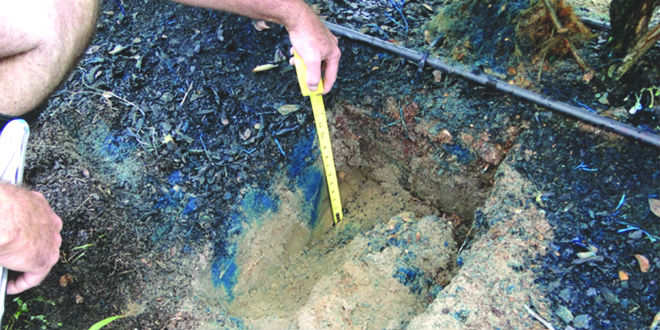Mar 29, 2016Irrigation water spread tracked in blueberries
One of the most important production practices to attain optimum blueberry yields is irrigation management.
Efficient application of supplemental irrigation will enhance crop yields and help reduce overall production costs.
With this in mind, Bob Hochmuth, a University of Florida Institute of Food and Agricultural Sciences (UF/ IFAS) regional specialized Extension agent and director of the Suwanee Valley Extension Demonstration Unit, initiated evaluations of irrigation water infiltration through the root zone in straight bark and incorporated bark culture on some major blueberry farms in central Florida, and one in south Georgia.
Speaking at the recent Southeast Regional Fruit and Vegetable Conference in Savannah, Georgia, Hochmuth made a presentation covering observations from the various locations


He displayed images that revealed some of the results observed in the trials in a central Florida blueberry farm. He showed a circle indicating some water had percolated below the root zone, but a majority was still available for uptake by the roots in an eight-minute irrigation duration in a 7-year-old straight pine bark bed.
Hochmuth also demonstrated that after a 13-minute irrigation cycle, additional dye had percolated beneath the root zone.
“Once the irrigation water encounters the native sand below the bark, the depth of irrigation water percolation deeper into the soil slows, but the width of the blue dye pattern increases,” he said. “This is typically observed in drip- irrigated vegetable fields in sandy soils where the irrigation water forms an onion shape as the waterfront increases.”
In order to evaluate irrigation water movement in commercial blueberries, Hochmuth described a demonstration that was conducted for both double line drip and overhead irrigation systems in 1- and 7-year old “straight pine bark” fields, and a 4-year-old “incorporated pine bark” field in central Florida, and for a single-line, drip-irrigated, 1-year old field in south Georgia.
Hochmuth noted these demonstrations were only preliminary work, to be utilized in future evaluations of irrigation water infiltration in blueberry fields of varying age, soil condition and irrigation system.
“We are hoping to attain funding for acquiring the appropriate equipment
to conduct these evaluations to assist blueberry growers to increase efficiency in the operation of their irrigation systems,” he said. “This has been a very popular tool for vegetable producers wishing to increase irrigation efficiency as part of their Best Management Practices (BMPs).”
Hochmuth is hopeful the blue dye approach can be as beneficial to blueberry producers as it has proven to be for vegetable growers in the region.
“For the past several years we’ve incorporated some field techniques where we utilized blue dye injected into the irrigation system to demonstrate how quickly water moves through the soil after an irrigation event,” he said.
“In the case of the irrigation decision- making process, the grower has two decisions – when to turn the irrigation on – and we have a lot of different ways to trigger that decision, with certainly a lot of work in soil moisture sensors and other mechanisms.
“The other question is how long do we run the irrigation system,” he said. “This dye test helps us to visualize through the soil profile how quickly the water moves.
“We’ve been working with vegetable growers over the last 10 years to demonstrate to them an efficient way of determining how long to run an irrigation event,” Hochmuth said. “We’ve done that work with vegetable crops, and had some interest among our blueberry industry to try the same procedure on various blueberry production systems both in Florida and Georgia.”
Pine bark system
Hochmuth said that in the blueberry production systems in those two states “most of them utilize pine bark as part of the production system. So in the case of pine bark where it is added to the surface, and only to the surface of the soil, is one method of production. The other method of production is where we would incorporate the pine bark into the soil, so we were able to inject our blue dye into those two various production systems, across different soil types, and were able to quantify how quickly the water moves.”
The difference between vegetable and blueberry irrigation impacts is significant, Hochmuth said.
“In vegetables, we typically would expect an irrigation event to be maybe 45 minutes in duration before we get to the bottom of the root system of the typical vegetable crop. However, we learned in this blueberry system that it’s quite different.”
He said the pine bark “makes it very difficult. To hold water for a very long period of time, therefore, the blue dye shows that the water runs very quickly through the rooting zone and can get down below the rooting zone in very short time intervals.
“So where we may be used to 45 minutes in a vegetable system, the blueberry system looks like on deep sandy soils, with pine bark on the system, it might be as little as eight to 10 minutes per event,” he said. “In that system, we certainly have learned you’re going to have to have many more irrigation events during the day, and they will have to be shorter in duration.
“The point of all of this is to make sure that if we begin to see whether the water is moving down below the root zone, we now know that we’re losing money by overwatering and also running the potential risk of leaching fertilizer down beyond the root zone.”
See more on blue dye: Using Blue Dye to Detect Irrigation Needs in Blueberries
— Gary Pullano, associate editor















